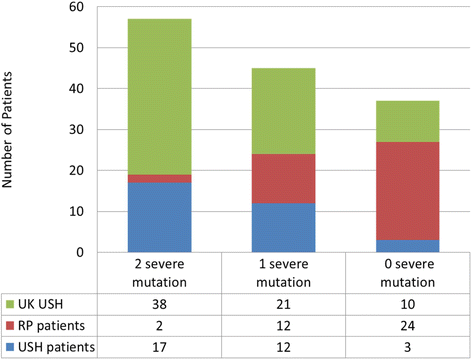Comprehensive molecular diagnosis of 67 Chinese Usher syndrome probands: high rate of ethnicity specific mutations in Chinese USH patients
- PMID: 26338283
- PMCID: PMC4559966
- DOI: 10.1186/s13023-015-0329-3
Comprehensive molecular diagnosis of 67 Chinese Usher syndrome probands: high rate of ethnicity specific mutations in Chinese USH patients
Abstract
Background: Usher syndrome (USH) is the most common disease causing combined deafness and blindness. It is predominantly an autosomal recessive genetic disorder with occasionally digenic cases. Molecular diagnosis of USH patients is important for disease management. Few studies have tried to find the genetic cause of USH in Chinese patients. This study was designed to determine the mutation spectrum of Chinese USH patients.
Methods: We applied next generation sequencing to characterize the mutation spectrum in 67 independent Chinese families with at least one member diagnosed with USH. Blood was collected at Peking Union Medical College Hospital. This cohort is one of the largest USH cohorts reported. We utilized customized panel and whole exome sequencing, variant analysis, Sanger validation and segregation tests to find disease causing mutations in these families.
Results: We identified biallelic disease causing mutations in known USH genes in 70 % (49) of our patients. As has been previously reported, MYO7A is the most frequently mutated gene in our USH type I patients while USH2A is the most mutated gene in our USH type II patients. In addition, we identify mutations in CLRN1, DFNB31, GPR98 and PCDH15 for the first time in Chinese USH patients. Together, mutations in CLRN1, DNFB31, GPR98 and PCDH15 account for 11.4 % of disease in our cohort. Interestingly, although the spectrum of disease genes is quite similar between our Chinese patient cohort and other patient cohorts from different (and primarily Caucasian) ethnic backgrounds, the mutations themselves are dramatically different. In particular, 76 % (52/68) of alleles found in this study have never been previously reported. Interestingly, we observed a strong enrichment for severe protein truncating mutations expected to have severe functional consequence on the protein in USH II patients compared to the reported mutation spectrum in RP patients, who often carry partial protein truncating mutations.
Conclusions: Our study provides the first comprehensive genetic characterization of a large collection of Chinese USH patients. Up to 90 % of USH patients have disease caused by mutations in known USH disease genes. By combining NGS-based molecular diagnosis and patient clinical information, a more accurate diagnosis, prognosis and personalized treatment of USH patients can be achieved.
Figures




References
Publication types
MeSH terms
Grants and funding
LinkOut - more resources
Full Text Sources
Other Literature Sources
Medical
Research Materials

